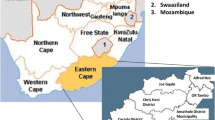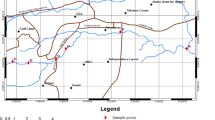Abstract
V. cholerae, V. parahaemolyticus, and V. vulnificus are recognized human pathogens. Although several studies are available worldwide, both on environmental and clinical contexts, little is known about the ecology of these vibrios in African coastal waters. In this study, their co-occurrence and relationships to key environmental constraints in the coastal waters of Guinea-Bissau were examined using the most probable number-polymerase chain reaction (MPN-PCR) approach. All Vibrio species were universally detected showing higher concentrations by the end of the wet season. The abundance of V. cholerae (ISR 16S-23S rRNA) ranged 0–1.2 × 104 MPN/L, whereas V. parahaemolyticus (toxR) varied from 47.9 to 1.2 × 105 MPN/L. Although the presence of genotypes associated with virulence was found in environmental V. cholerae isolates, ctxA+ V. cholerae was detected, by MPN-PCR, only on two occasions. Enteropathogenic (tdh+ and trh+) V. parahaemolyticus were detected at concentrations up to 1.2 × 103 MPN/L. V. vulnificus (vvhA) was detected simultaneously in all surveyed sites only at the end of the wet season, with maximum concentrations of 1.2 × 105 MPN/L. Our results suggest that sea surface water temperature and salinity were the major environmental controls to all Vibrio species. This study represents the first detection and quantification of co-occurring Vibrio species in West African coastal waters, highlighting the potential health risk associated with the persistence of human pathogenic Vibrio species.



Similar content being viewed by others
References
Alam M, Hasan NA, Sadique A, Bhuiyan NA, Ahmed KU, Nusrin S, et al. (2006) Seasonal cholera caused by Vibrio cholerae serogroups O1 and O139 in the coastal aquatic environment of Bangladesh. Applied and Environmental Microbiology 72(6):4096–4104. doi:10.1128/AEM.00066-06
Ansaruzzaman M, Lucas M, Deen JL, Bhuiyan NA, Wang XY, Safa A, et al. (2005) Pandemic serovars (O3: K6 and O4: K68) of Vibrio parahaemolyticus associated with diarrhea in Mozambique: Spread of the pandemic into the African continent. Journal of Clinical Microbiology 43(6):2559-2562. doi:10.1128/JCM.43.6.2559-2562.2005
Barrett JE, Virginia RA, Wall DH, Cary SC, Adams BJ, Hacker AL, et al. (2006) Co-variation in soil biodiversity and biogeochemistry in northern and southern Victoria Land, Antarctica. Antarctic Science 18(4):535-548. doi:10.1017/S0954102006000587
Bej AK, Patterson DP, Brasher CW, Vickery MCL, Jones DD, Kaysner CA (1999) Detection of total and hemolysin-producing Vibrio parahaemolyticus in shellfish using multiplex PCR amplification of tl, tdh and trh. Journal of Microbiological Methods 36(3):215-225. doi:10.1016/S0167-7012(99)00037-8
Blackwell KD, Oliver JD (2008) The ecology of Vibrio vulnificus, Vibrio cholerae, and Vibrio parahaemolyticus in North Carolina estuaries. Journal of Microbiology 46(2):146-153. doi:10.1007/s12275-007-0216-2
Bockemühl J, Triemer A (1974) Ecology and epidemiology of Vibrio parahaemolyticus on the coast of Togo. Bulletin of the World Health Organization 51(4):353-360
Bordalo AA (2003) Microbiological water quality in urban coastal beaches: The influence of water dynamics and optimization of the sampling strategy. Water Research 37(13):3233-3241. doi:10.1016/S0043-1354(03)00152-0
Bordalo AA, Savva-Bordalo J (2012) The water question under extreme poverty: The example of Bolama, Guinea-Bissau (West Africa). In: Water Governance—Challenges in Africa: Hydro-optimism or Hydro-pessimism? CEAUP Studies on Africa, Vol. 2, Ibrahima A (editor), Bern, Berlin, Bruxelles, Frankfurt am Main, New York, Oxford, Wien: Peter Lang, pp 143–164
Bordalo AA, Savva-Bordalo J (2007) The quest for safe drinking water: An example from Guinea-Bissau (West Africa). Water Research 41(13):2978-2986. doi:10.1016/j.watres.2007.03.021
Brasher CW, DePaola A, Jones DD, Bej AK (1998) Detection of microbial pathogens in shellfish with multiplex PCR. Current Microbiology 37(2):101-107. doi:10.1007/s002849900346
Cantet F, Hervio-Heath D, Caro A, Le Mennec C, Monteil C, Quéméré C, et al. (2013) Quantification of Vibrio parahamolyticus, Vibrio vulnificus and Vibrio cholerae in French Mediterranean coastal lagoons. Research in Microbiology 164(8):867-874. doi:10.1016/j.resmic.2013.06.005
Chun J, Huq A, Colwell RR (1999) Analysis of 16S-23S rRNA intergenic spacer regions of Vibrio cholerae and Vibrio mimicus. Applied and Environmental Microbiology 65(5):2202-2208.
Coly I, Sow AG., Seydi M, Martinez-Urtaza J (2013) Vibrio cholerae and Vibrio parahaemolyticus detected in seafood products from Senegal. Foodborne Pathogen and Disease 10(12):1050-1058. doi:10.1089/fpd.2013.1523
Dalsgaard A, Forslund A, Petersen A, Brown DJ, Dias F, Monteiro S, et al. (2000) Class 1 integron-borne, multiple-antibiotic resistance encoded by a 150-kilobase conjugative plasmid in epidemic Vibrio cholerae O1 strains isolated in Guinea-Bissau. Journal of Clinical Microbiology 38(10):3774-3779
Dalsgaard A, Mortensen HF, Mølbak K, Dias F, Serichantalergs O, Echeverria P (1996) Molecular characterization of Vibrio cholerae O1 strains isolated during cholera outbreaks in Guinea-Bissau. Journal of Clinical Microbiology 34(5):1189-1192
De R, Ghosh JB, Gupta SS, Takeda Y, Nair GB (2013) The role of Vibrio cholerae genotyping in Africa. Journal of Infectious Diseases 208(1):S32-S38. doi:10.1093/infdis/jit199
De Man JC (1983) MNP Tables, Corrected. European Journal of Applied Microbiology and Biotechnology 17(5):301-305. doi:10.1007/BF00508025
Dempster EL, Pryor KV, Francis D, Young JE, Rogers HJ (1999) Rapid DNA extraction from ferns for PCR-based analyses. Biotechniques 27(1):66-68
Deter J, Lozach S, Derrien A, Véron A, Chollet J, Hervio-Heath D (2010) Chlorophyll a might structure a community of potentially pathogenic culturable Vibrionaceae. Insights from a one-year study of water and mussels surveyed on the French Atlantic coast. Environmental Microbiology Reports 2(1):185-191. doi:10.1111/j.1758-2229.2010.00133.x
Drake SL, DePaola A, Jaynus LA (2007) An Overview of Vibrio vulnificus and Vibrio parahaemolyticus. Comprehensive Reviews in Food Science and Food Safety 6(4):120-144. doi:10.1111/j.1541-4337.2007.00022.x
Fields PI, Popovic T, Waschsmuth K, Olsvik Ø (1992) Use of polymerase chain reaction for detection of toxigenic Vibrio cholerae O1 strains from the Latin American cholera epidemic. Journal of Clinical Microbiology 30(8): 2118-2121.
Fries JS, Characklis GW, Noble RT (2008) Sediment-water exchange of Vibrio sp. and fecal indicator bacteria: Implications for persistence and transport in the Neuse River Estuary, North Carolina, USA. Water Research 42(4-5):941-950. doi:10.1016/j.watres.2007.09.006
Fukushima H, Seki R (2004) Ecology of Vibrio vulnificus and Vibrio parahaemolyticus in brackish environments of the Sada River in Shimane Prefecture, Japan. FEMS Microbiology Ecology 48(2):221-229. doi:10.1016/j.femsec.2004.01.009
Gil AI, Louis VR, Rivera IN, Lipp E, Huq A, Lanata CF, et al. (2004) Occurrence and distribution of Vibrio cholerae in the coastal environment of Peru. Environmental Microbiology 6(7):699-706. doi:10.1111/j.1462-2920.2004.00601.x
Gutierrez WCK, Klein SL, Lovell CR (2013) High frequency of virulence factor genes tdh, trh, and tlh in Vibrio parahaemolyticus strains isolated from a pristine estuary. Applied and Environmental Microbiology 79(7):2247-2252. doi:10.1128/AEM.03792-12
Igbinosa EO, Obi LC, Okoh AI (2009) Occurrence of potentially pathogenic vibrios in final effluents of a wastewater treatment facility in a rural community of the Eastern Cape Province of South Africa. Research in Microbiology 160(8):531-537. doi:10.1016/j.resmic.2009.08.007
Iida T, Park KS, Honda T (2006) Vibrio parahaemolyticus. In: Biology of Vibrios, Thompson FL, Austin B, Swings J (editors.), Washington, DC: ASM Press, pp 341–348
Islam MS, Mahmud ZH, Ansaruzzaman M, Faruque SM, Talukder KA, Qadri F, et al. (2011) Phenotypic, genotypic, and antibiotic sensitivity patterns of strains isolated from the cholera epidemic in Zimbabwe. Journal of Clinical Microbiology 49(6):2325-2327. doi:10.1128/JCM.00432-11
Johnson CN, Bowers JC, Griffitt KJ, Molina V, Clostio RW, Pei S, et al. (2012) Ecology of Vibrio parahaemolyticus and Vibrio vulnificus in the coastal and estuarine waters of Louisiana, Maryland, Mississippi, and Washington (United States). Applied and Environmental Microbiology 78(20):7249-7257. doi:10.1128/AEM.01296-12
Johnson CN, Flowers AR, Noriea III NF, Zimmerman AM, Bowers JC, DePaola A, et al. (2010) Relationships between environmental factors and pathogenic Vibrios in the Northern Gulf of Mexico. Applied and Environmental Microbiology 76(21):7076-7084. doi:10.1128/AEM.00697-10
Kendall M (1938) A new measure of rank correlation. Biometrika 30(1-2):81-89. doi:10.1093/biomet/30.1-2.81
Kim YB, Okuda J, Matsumoto C, Takahashi N, Hashimoto S, Nishibuchi M (1999) Identification of Vibrio parahaemolyticus strains at the species level by PCR targeted to the toxR Gene. Journal of Clinical Microbiology 37(4):1173-1177
Koh EG, Huyn JH, LaRock PA (1994) Pertinence of indicator organisms and sampling variables to Vibrio concentrations. Applied and Environmental Microbiology 60(10):3897-3900
Lipp EK, Rodriguez-Palacios C, Rose JB (2001) Occurrence and distribution of the human pathogen Vibrio vulnificus in a subtropical Gulf of Mexico estuary. Hydrobiologia 460(1-3):165-173. doi:10.1023/A:1013127517860
Luan X, Chen J, Liu Y, Jia J, Liu R, Zhang XH (2008) Rapid quantification of Vibrio parahaemolyticus in seafood by MPN-PCR. Current Microbiology 57(3):218-221. doi:10.1007/s00284-008-9177-x
Luquero FJ, Na Banga C, Remartínez D, Palma PP, Baron E, Grais RF (2011) Cholera epidemic in Guinea-Bissau (2008): The Importance of ‘‘Place’’. PLoS ONE 6(5):e19005. doi:10.1371/journal.pone.0019005
Machado A, Bordalo AA (2014) Diversity and dynamics of the Vibrio community in well water used for drinking in Guinea-Bissau (West Africa). Environmental Monitoring and Assessment 186(9):5697-5709. doi:10.1007/s10661-014-3813-7
Miwa N, Nishio T, Arita Y, Kawamori F, Masuda T, Akiyama M (2003) Evaluation of MPN method combined with PCR procedure for detection and enumeration of Vibrio parahaemolyticus in seafood. Journal of the Food Hygienic Society of Japan 44(6):289-293. doi:10.3358/shokueishi.44.289
Mahmud ZH, Neogi SB, Kassu A, Mai Huong BT, Jahid IK, Islam MS, et al. (2008) Occurrence, seasonality and genetic diversity of Vibrio vulnificus in coastal seaweeds and water along the Kii Channel, Japan. FEMS Microbiology Ecology 64(2):209-218. doi:10.1111/j.1574-6941.2008.00460.x
Neogi SB, Islam MS, Nair GB, Yamasaki S, Lara R J (2012). Occurrence and distribution of plankton-associated and free-living toxigenic Vibrio cholerae in a tropical estuary of a cholera endemic zone. Wetlands Ecology and Management 20(3):271-285. doi:10.1007/s11273-012-9247-5
Oliver JD, Pruzzo C, Vezzulli L, Kaper JB (2013) Vibrio species. In: Food microbiology: Fundamentals and frontiers, Doyle MP, Buchanan RL (editors), Washington: ASM Press, pp 401–440. doi:10.1128/9781555818463.ch16
Pfeffer CS, Hite MF, Oliver JD (2003) Ecology of Vibrio vulnificus in estuarine waters of eastern North Carolina. Applied and Environmental Microbiology 69(6):3526-3531. doi:10.1128/AEM.69.6.3526-3531.2003
Randa MA, Poltz MF, Lim E (2004) Effects of temperature and salinity on Vibrio vulnificus population dynamics as assessed by quantitative PCR. Applied and Environmental Microbiology 70(9):5469-5476. doi:10.1128/AEM.70.9.5469-5476.2004
Rivera S, Lugo T, Hazen TC (1989) Autecology of Vibrio vulnificus and Vibrio parahaemolyticus in tropical waters. Water Research 23(7):923-931. doi:10.1016/0043-1354(89)90018-3
Taviani E, Ceccarelli D, Lazaro N, Bani S, Cappuccinelli P, Colwell RR, et al. (2008) Environmental Vibrio spp., isolated in Mozambique, contain a polymorphic group of integrative conjugative elements and class 1 integrons. FEMS Microbiology Ecology 64(1):45-54. doi:10.1111/j.1574-6941.2008.00455.x
Thompson FL, Iida T, Swings J (2004a) Biodiversity of vibrios. Microbiology and Molecular Biology Reviews 68(3):403-431. doi:10.1128/MMBR.68.3.403-431.2004
Thompson JR, Randa MA, Marcelino LA, Tomita-Mitchell A, Lim E, Polz MF (2004b) Diversity and dynamics of a north Atlantic coastal Vibrio community. Applied and Environmental Microbiology 70(7):4103-4110. doi:10.1128/AEM.70.7.4103-4110.2004
Valia R, Taviani E, Spagnoletti M, Ceccarelli D, Cappuccinelli P, Colombo MM (2013) Vibrio cholerae O1 epidemic variants in Angola: a retrospective study between 1992 and 2006. Frontiers in Microbiology 4:354. doi:10.3389/fmicb.2013.00354
Vezzulli L, Colwell RR, Pruzzo C (2013). Ocean warming and spread of pathogenic vibrios in the aquatic environment. Microbial Ecology 65(4):817-825. doi:10.1007/s00248-823012-0163-2
Watkins WD, Cabelli VJ (1985) Effect of fecal pollution on Vibrio parahaemolyticus densities in an estuarine environment. Applied and Environmental Microbiology 49(5):1307-1313.
World Health Organization (2013) Cholera country profile: Guinea-Bissau. Retrieved from: http://www.who.int/cholera/countries/GuineaBissauCountryProfile2013.pdf
World Health Organization (2014) Cholera, 2013. Weekly Epidemiological Record 89(31):345-356
Yamamoto K, Wright AC, Kaper JB, Morris JB (1990) The cytolysin gene of Vibrio vulnificus: Sequence and relationship to the Vibrio cholerae El Tor hemolysin gene. Infection and Immunity 58(8):2706-2709
Zimmerman AM, DePaola A, Bowers JC, Krantz JA, Nordstrom JL, Johnson CN, et al. (2007) Variability of total and pathogenic Vibrio parahaemolyticus densities in northern Gulf of Mexico water and oysters. Applied and Environmental Microbiology 73(23):7589-7596. doi:10.1128/AEM.01700-07
Acknowledgments
We thank Eva Amorim for statistical assistance and oceanographic database management. This study was partially funded through a PhD fellowship to A. Machado (SFRH/BD/46146/2008) co-financed by POPH/FSE, and a grant to A. Bordalo (PTDC/AAC-CLI/103539/2008). This research was also partially supported by the European Regional Development Fund (ERDF) through the COMPETE—Operational Competitiveness Programme and national funds through FCT—Foundation for Science and Technology, under the project “PEst-C/MAR/LA0015/2013.”
Author information
Authors and Affiliations
Corresponding author
Rights and permissions
About this article
Cite this article
Machado, A., Bordalo, A.A. Detection and Quantification of Vibrio cholerae, Vibrio parahaemolyticus, and Vibrio vulnificus in Coastal Waters of Guinea-Bissau (West Africa). EcoHealth 13, 339–349 (2016). https://doi.org/10.1007/s10393-016-1104-1
Received:
Revised:
Accepted:
Published:
Issue Date:
DOI: https://doi.org/10.1007/s10393-016-1104-1




